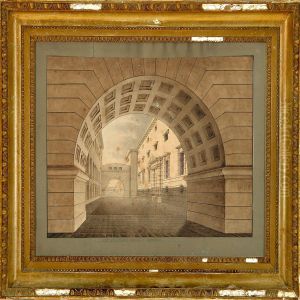C. F. Hansen Paintings
Christian Frederik Hansen, often known simply as C. F. Hansen, was a prominent Danish architect who played a key role in the development of Neoclassicism in Northern Europe during the late 18th and early 19th centuries. Born on February 29, 1756, in Copenhagen, Hansen's architectural style was characterized by its simplicity, symmetry, and use of classical elements, which was in stark contrast to the more elaborate styles that had been popular during the Baroque period.
Hansen started his career as an architect in the 1770s and first gained recognition for his work on country houses and smaller projects. However, his reputation grew significantly when he was appointed as the city architect of Copenhagen in 1794, following the great fire of 1795 which destroyed large parts of the city. His work during this period focused on rebuilding the city with an emphasis on enduring materials like brick and stone, fire safety, and classical aesthetics. His notable works from this period include the Copenhagen Cathedral, also known as the Church of Our Lady, and the Copenhagen Court House.
In 1804, Hansen was appointed as the Royal Building Inspector for Zealand, which further solidified his influence in Danish architecture. During this time, he designed a number of important public buildings, such as the Metropolitan School and the Charity School, both of which are admired for their Neoclassical facades and well-proportioned structure.
C. F. Hansen's work is seen as a testament to the Danish Golden Age of architecture, a period characterized by creativity and a revival of classical forms. His designs often reflected the principles of clarity, order, and beauty, which were central to the Neoclassical movement. He received numerous honors for his architectural contributions, including the title of professor from the Royal Danish Academy of Fine Arts.
Hansen continued to work until his death on August 10, 1845, in Copenhagen. His legacy in Danish architecture is profound, with many of his buildings still standing and considered national treasures. Hansen's influence extended beyond Denmark, as his style and principles contributed to the wider European Neoclassical movement, which sought to reflect the democratic ideals and rationalism of the period.
